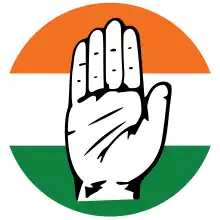West Bengal Pradesh Congress Committee
The West Bengal Pradesh Congress Committee (WBPCC), formerly known as the Bengal Provincial Congress Committee in Colonial India, is the unit of the Indian National Congress for the state of West Bengal. It is responsible for the organization and management of the party's activities and campaigns in the state, as well as selecting candidates for local, state, and national elections. The current president of the West Bengal Pradesh Congress Committee is Adhir Ranjan Chowdhury, who is also a Member of Parliament from Berhampore in West Bengal.
West Bengal Pradesh Congress Committee পশ্চিমবঙ্গ প্রদেশ কংগ্রেস কমিটি | |
|---|---|
 | |
| President | Adhir Ranjan Chowdhury |
| Founded | 19 June 1966 |
| Headquarters | 104E, Dr. Lalmohon Bhattacharjee Road, Kolkata-700014, West Bengal |
| Student wing | West Bengal State Chhatra Parishad |
| Ideology | |
| Political position | Centre[10] to centre-left[14] |
| Alliance | Indian National Developmental Inclusive Alliance |
| Seats in Lok Sabha | 2 / 42
|
| Seats in Rajya Sabha | 1 / 16
|
| Seats in West Bengal Legislative Assembly | 0 / 294
|
| Seats in Gorkhaland Territorial Administration | 0 / 62
|
| Election symbol | |
 | |
| Website | |
| wbpcc | |
Chief Ministers
There were four Chief Ministers of West Bengal from the Congress party:
- Prafulla Chandra Ghosh (1947-1948;1967-1968).
- Bidhan Chandra Roy (1948-1962).
- Prafulla Chandra Sen (1962-1967).
- Siddhartha Shankar Ray (1972-1977).
The Congress Party was popular in West Bengal from the beginning till the late 1970s. The party was voted out of power in 1977 due to the Emergency. After that, they played the role of the opposition during the Left Front regime. The party suffered a big blow when Mamata Banerjee left the Congress and founded the breakaway party of Trinamool Congress (TMC). This led to exodus of the party members to the TMC and demise of the Congress Party. The party further declined due to the rise of the BJP in West Bengal is the mid 2010s, relegating the party to a mere third-party status in the state. In the Legislative Assembly election in 2021, for the first time the party drew blank and failed to win a single seat in the assembly.
References
- N. S. Gehlot (1991). The Congress Party in India: Policies, Culture, Performance. Deep & Deep Publications. pp. 150–200. ISBN 978-81-7100-306-8.
- Soper, J. Christopher; Fetzer, Joel S. (2018). Religion and Nationalism in Global Perspective. Cambridge University Press. pp. 200–210. ISBN 978-1-107-18943-0.
- DeSouza, Peter Ronald (2006). India's Political Parties Readings in Indian Government and Politics series. SAGE Publishing. p. 420. ISBN 978-9-352-80534-1.
- Rosow, Stephen J.; George, Jim (2014). Globalization and Democracy. Rowman & Littlefield. pp. 91–96. ISBN 978-1-442-21810-9.
- Lowell Barrington (2009). Comparative Politics: Structures and Choices. Cengage Learning. p. 379. ISBN 978-0-618-49319-7.
- Agrawal, S. P.; Aggarwal, J. C., eds. (1989). Nehru on Social Issues. New Delhi: Concept Publishing. ISBN 978-817022207-1.
- Meyer, Karl Ernest; Brysac, Shareen Blair (2012). Pax Ethnica: Where and How Diversity Succeeds. PublicAffairs. p. 50. ISBN 978-1-61039-048-4. Retrieved 7 April 2016.
- "Political Parties – NCERT" (PDF). National Council of Educational Research and Training. Retrieved 8 May 2021.
- Jean-Pierre Cabestan, Jacques deLisle, ed. (2013). Inside India Today (Routledge Revivals). Routledge. ISBN 978-1-135-04823-5.
... were either guarded in their criticism of the ruling party — the centrist Indian National Congress — or attacked it almost invariably from a rightist position. This was so for political and commercial reasons, which are explained, ...
- [8][9][5]
- "India Election 2019: A Simple Guide to the World's Largest Vote". The New York Times. 22 May 2019. Retrieved 11 January 2023.
The Indian National Congress led India for most of the nation's post-independence history. This secular, center-left party's leader is Rahul Gandhi, whose father, grandmother and great-grandfather were prime ministers.
- S. Harikrishnan, ed. (2022). Social Spaces and the Public Sphere: A Spatial-history of Modernity in Kerala. Taylor & Francis. ISBN 9781000786583.
Electorally, both the left-leaning Communist parties (and allies) and the centre-left Indian National Congress (and allies) have been active in Kerala.
- Shekh Moinuddin, ed. (2021). Digital Shutdowns and Social Media: Spatiality, Political Economy and Internet Shutdowns in India. Springer Nature. p. 99. ISBN 9783030678883.
Meanwhile, in the last four years, there has been a shift in social content and strategy of the BJP and the major opposition party, centre-left Indian National Congress (INC).
- [11][12][13]